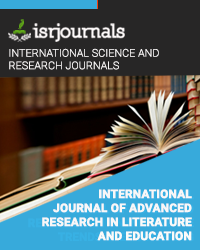the tensions, conflicts and the sense of rootedness and belonging
C.Vinothkumar,
Published in International Journal of Advanced Research in Literature and Education
ISSN: 2348-2346 Impact Factor:1.9 Volume:1 Issue:2 Year: 11 April,2011 Pages:27-31

Abstract
Caged Eagles, a sequel to the 1998 novel the War of the Eagles, is a well researched book describes the confusion and resignation of three generations of the Fukushima family. All the Japanese Canadians living in a fishing village in British Columbia are placed in an internment camp in Vancouver by the Canadian government during World War II. The story is told from the point of view of Fourteen-year-old Tadashi who tries to understand the injustice of their internment and cannot believe that his hard working father and other Japanese men in the camp could really be spies. This historical fiction educates its readers about an embarrassing period in both American and Canadian history when both countries ill-treated its own citizens during World War II because of their ethnicity. In an afterword, the author shares his experiences in writing this fiction book without changing major facts of history. Though it is a sequel to "War of the Eagles," this book is a story by itself. When Canada went to war with Japan following the bombing of Pearl Harbour, Canadians of Japanese descent were declared "Enemy Aliens." Without recourse of any kind, they were forced to leave their homes along with the British Columbia coast, their possessions were sold, and their rights as citizens denied.
Kewords
Racism and Injustice
Reference
1. Anderson (2012). The application of open educational resources to EAP curriculum. Retrieved from The Connexious Project. P (1- 10). http://cnx.org/content/m43623/1.1/ 2. Andy B. Lane (2008). Open Learn: Sharing and shaping open educational resource. Retrieved from http://universitydesign.asu.edu/db/openlear n-sharing-and-shaping-open-educational- resource 3. Bruner, J.(1996). Constructivist Theory. Retrieved from http://www.instructionaldesign.org/theories/cons tructivist.html 4. Dhaif H., (2004). ―Computer Assisted Language Learning: A Client's View, Computer Journal Assisted Language Instruction Consortium, vol.7, no. 2, pp. 467-469. 5. Howard . J. Guidelines for Designing Effective Language Teaching Materials. Retrieved from http://www.paaljapan.org/resources/proceedings/ PAAL9/pdf/Howard.pdf 6. Kristinsdóttir, S.B. (2001). Constructivist Theories. Retrieved from http://mennta.hi.is/starfsfolk/solrunb/constr uc.htm 7. Lai Lai Kwan, (1999). A Tutor-Guided Learning Scheme in a Self-Access Centre. Retrieved from http://iteslj.org/Techniques/Lai-Tutor- Guided.html The Internet TESL Journal. Vol, No. 9. 8. Nelson. E, Ward. M, and Kaplow.R. (1976). Two New Strategies for Computer Assisted Language Instuction, Computer Journal of Foreign Annals, vol. 9, no.2 pp. 28-37. 9. Nunan, D. (1987). The teacher as a curriculum developer: An investigation of curriculum processes within the Adult Migrant Education Program. South Australia: National Curriculum Resource Centre, p. 75. 10. Nunan, D. (1988). Principles for designing language teaching materials. Guidelines, Okada, 10(2), 1–24. 11. Podromou, L. (2002). The great ELT textbook debate. MET, 11 (4), 25–33. 12. Richard Jack C and Charles Lockhart, (1990). Reflective Teaching in Second Language Classrooms, Cambridge University Press. p. 6. 13. Son, J.-B. (2007). Learner experiences in web- based language learning. Computer Assisted Language Learning. 20(1), 21-36. 14. Thakrar, J., Zinn, D. & Wolfenden, F. (2009). Harnessing Open Educational Resources to the Challenges of Teacher Education in Sub- Saharan Africa. Retrieved from http://www.irrodl.org/index.php/irrodl/arti cle/view/705/1319 (n.d). 15. Vicki Trowler (2010). Student engagement literature review

